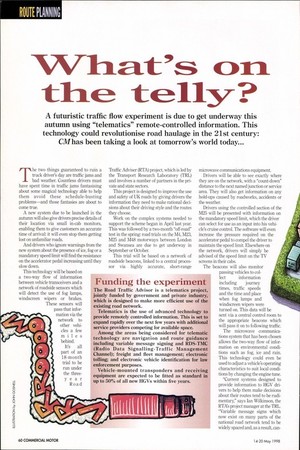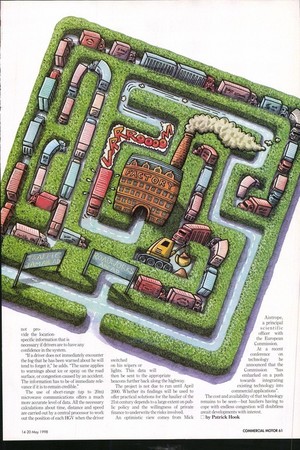cori -the ?
Page 72

Page 73

If you've noticed an error in this article please click here to report it so we can fix it.
A futuristic traffic flow experiment is due to get underway this autumn using "telematics" remote-controlled information. This technology could revolutionise road haulage in the 21st century: CM has been taking a look at tomorrow's world today...
The two things guaranteed to ruin a truck driver's day are traffic jams and bad weather. Countless drivers must have spent time in traffic jams fantasising about some magical technology able to help them avoid these schedule-busting problems—and those fantasies are about to come true.
A new system due to be launched in the autumn will also give drivers precise details of their location via small in-cab monitors, enabling them to give customers an accurate time of arrival: it will even stop them getting lost on unfamiliar roads.
And drivers who ignore warnings from the new system about the presence of ice, fog or a mandatory speed limit will find the resistance on the accelerator pedal increasing until they slow down.
This technology will be based on a two-way flow of information between vehicle transceivers and a network of roadside sensors which will detect the use of fog lamps, windscreen wipers or brakes. These sensors will pass that information via the network to other vehicles a few miles behind.
It's all part of an 18-month trial to be run under the threeyear Road Traffic Adviser (RTA) project, which is led by the Transport Research Laboratory (TRL) and involves a number of partners in the private and state sectors.
This project is designed to improve the use and safety of UK roads by giving drivers the information they need to make rational decisions about their driving style and the routes they choose.
Work on the complex systems needed to support the scheme began in April last year. This was followed by a two-month "off-road" test in the spring: road trials on the M4, M23, M25 and M48 motorways between London and Swansea are due to get underway in September or October.
This trial will be based on a network of roadside beacons, linked to a central processor via highly accurate, short-range microwave communications equipment.
Drivers will be able to see exactly where they are on the network, with a "count-down" distance to the next named junction or service area. They will also get information on any hold-ups caused by roadworks, accidents or the weather.
Drivers using the controlled section of the M25 will be presented with information on the mandatory speed limit, which the driver can select for use as an input into his vehicle's cruise control. The software will even increase the pressure required on the accelerator pedal to compel the driver to maintain the speed limit. Elsewhere on the network, drivers will simply be advised of the speed limit on the TV screens in their cabs.
The beacons will also monitor passing vehicles to col lect information including journey times, traffic speeds and the time and place when fog lamps and windscreen wipers were turned on. This data will be sent via a central control room to the appropriate beacons which will pass it on to following traffic.
The microwave communications system that has been chosen allows the two-way flow of information on environmental conditions such as fog, ice and rain. This technology could even be used to adjust a vehicle's operating characteristics to suit local conditions by changing the engine tune.
"Current systems designed to provide information to HGV drivers to help them make decisions about their routes tend to be rudimentary," says Ian Wilkinson, the RTSs project manager at the TRL. "Variable message signs which now exist on many parts of the national road network tend to be widely spaced and, as a result, can not pro vide the locationspecific information that is necessary if drivers are to have any confidence in the system.
"If a driver does not immediately encounter the fog that he has been warned about he will tend to forget it," he adds. "The same applies to warnings about ice or spray on the road surface, or congestion caused by an accident. The information has to be of immediate relevance if it is to remain credible."
The use of short-range (up to 20m) microwave communications offers a much more accurate level of data. All the necessary calculations about time, distance and speed are carried out by a central processor to work out the position of each HGV when the driver switched on his wipers or lights. This data will then be sent to the appropriate beacons further back along the highway.
The project is not due to run until April 2000. Whether its findings will be used to offer practical solutions for the haulier of the 21st century depends to a large extent on public policy and the willingness of private finance to underwrite the risks involved.
An optimistic view comes from Mick Aistrope, a principal scientific officer with the European Commission. At a recent conference on technology he announced that the Commission "has embarked on a push towards integrating existing technology into commercial applications". The cost and availability of that technology remains to be seen—but hauliers having to cope with endless congestion will doubtless await developments with interest.
D by Patrick Hook Funding the experiment The Road Traffic Advisor is a telematics project, jointly funded by government and private industry, which is designed to make more efficient use of the existing road network.
Telematics is the use of advanced technology to provide remotely controlled information. This is set to expand rapidly over the next few years with additional service providers competing for available space.
Among the areas being considered for telematic technology are navigation and route guidance including variable message signing and RDS-TMC (Radio Data Signalling-Traffic Management Channel); freight and fleet management; electronic tolling; and electronic vehicle identification for law enforcement purposes.
Vehicle-mounted transponders and receiving equipment are expected to be fitted as standard in up to 50% of all new HGVs within five years.




































































































































